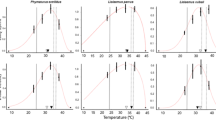Summary
Female Eumeces laticeps experience a substantial decrease in running speed (ca. 25%) and an even greater loss of endurance (slightly over 50%) while gravid. Because some widely foraging lizards, including E. laticeps, rely primarily on running to escape predators, the decreases in speed and stamina may contribute to an increased risk of predation. However, observations suggest that gravid females become less active or conspicuous on the surface. Ambush foraging lizards rely relatively more on crypsis associated with immobility to avoid predation and thus can have greater average relative clutch mass (RCM) than active foragers. Behavioral compensation for locomotor impairment by becoming less active or conspicuous may allow some species the advantages inherent in both high relative clutch mass when gravid and the increased energetic profitability of active foraging when not gravid. As females gain weight during the breeding season, they may forage actively until the risk due to increasing locomotor impairment becomes too great and then change defensive strategy to greater reliance on crypsis. Without such a shift, widely foraging squamate reptiles may be less able than ambush foragers to exploit life-historical strategies demanding high current investment in reproduction.
Similar content being viewed by others
References
Anderson RA, Karasov WH (1981) Contrasts in energy intake and expenditure in sit-and-wait and widely foraging lizards. Oecologia 49: 67–72
Andren C (1985) Risk of predation in male and female adders, Vipera berus (Linne). Amphib Reptilia 6:203–206
Bauwens D, Thoen C (1981) Escape tactics and vulnerability to predation associated with reproduction in the lizard Lacerta vivipara. J Anim Ecol 50:733–743
Brodie ED III (1989) Behavioral modification as a means of reducing the cost of reproduction. Am Nat 134:225–238
Cooper WE Jr, Vitt LJ (1985) Blue tails and autotomy: enhancement of predation avoidance in juvenile skinks. Z Tierpsychol 70:265–276
Dunham AE, Miles DB, Reznick DN (1988a) Life history patterns in squamate reptiles. In: Gans C, Huey RB (eds) Biology of the reptilia, vol 16, ecology B: defense and life history. A.R. Liss, New York, pp 443–522
Dunham AE, Morin PJ, Wilbur HM (1988b) Methods for the study of reptile populations. In: Gans C, Huey RB (eds) Biology of the reptilia, vol 16, ecology B: defense and life history. A.R. Liss, New York, pp 331–386
Garland T Jr (1985) Ontogenetic and individual variation in size, shape and speed in the Australian agamid lizard Amphibolurus nuchalis. J Zool (Lond), Ser A 207:425–439
Garland T Jr, Arnold SJ (1983) Effects of a full stomach on locomotory performance of juvenile garter snakes (Thamnophis elegans). Copeia 1983:1092–1096
Garland T Jr, Else PL, Hulbert AJ, Tap P (1987) Effects of endurance training and captivity on activity metabolism of lizards. Am J Physiol 252:450–456
Gerritson J, Strickler JR (1977) Encounter probabilities and community structure in zooplankton: a mathematical model. J Fish Res Board Can 34:73–82
Hertz PE, Huey RB, Nevo E (1983) Homage to Santa Anita: thermal sensitivity of sprint speed in agamid lizards. Evolution 37:1075–1084
Hertz PF, Huey RB, Garland T Jr (1988) Time budgets, thermoregulation, and maximal locomotor performance: are reptiles olympians or boy scouts? Am Zool 28:927–938
Huey RB, Hertz PE (1982) Effects of body size and of slope on sprint speed of a lizard Stellio (Agama) stellio. J Exp Biol 97:401–409
Huey RB, Pianka ER (1981) Ecological consequences of foraging mode. Ecology 62:991–999
Huey RB, Bennett AF, John-Alder H, Nagy KA (1984) Locomotor capacity and foraging behaviour of Kalahari lacertid lizards. Anim Behav 32:41–50
Madsen T (1987) Cost of reproduction and female life-history tactics in a population of grass snakes, Natrix natrix, in southern Sweden. Oikos 49:129–132
Nagy KA, Huey RB, Bennett AF (1984) Field energetics and foraging mode of Kalahari lacertid lizards. Ecology 65:588–596
Reznick D (1985) Costs of reproduction: an evaluation of the empirical evidence. Oikos 44:257–267
Seigel RA, Huggins MM, Ford NB (1987) Reduction in locomotor ability as a cost of reproduction in gravid snakes. Oecologia 73:481–485
Shine R (1980) “Costs” of reproduction in reptiles. Oecologia 46:92–100
Shine R (1988a) Constraints on reproductive investment: a comparison between aquatic and terrestrial snakes. Evolution 42:17–27
Shine R (1988b) Parental care in reptiles. In: Gans C, Huey RB (eds) Biology of the reptilia, vol 16, ecology B: defense and life history. A.R. Liss, New York, pp 275–329
Sokal RR, Rohlf JF (1981) Biometry: the principles and practice of statistics in biological research, 2nd edn. W.H. Freeman, San Francisco
Vitt LJ, Congdon JD (1978) Body shape, reproductive effort, and relative clutch mass in lizards: resolution of a paradox. Am Nat 112:595–608
Vitt LJ, Cooper WE Jr (1985) The relationship between reproduction and lipid cycling in the skink Eumeces laticeps with comments on brooding ecology. Herpetologica 41:419–432
Vitt LJ, Cooper WE Jr (1986) Foraging and diet of a diurnal predator (Eumeces laticeps) feeding on hidden prey. J Herpetol 20:408–415
Vitt LJ, Cooper WE Jr (1989) Maternal care in skinks. J Herpetol 23:29–34
Vitt LJ, Price HJ (1982) Ecological and evolutionary determinants of relative clutch mass in lizards. Herpetologica 38:237–255
Author information
Authors and Affiliations
Rights and permissions
About this article
Cite this article
Cooper, W.E., Vitt, L.J., Hedges, R. et al. Locomotor impairment and defense in gravid lizards (Eumeces laticeps): behavioral shift in activity may offset costs of reproduction in an active forager. Behav Ecol Sociobiol 27, 153–157 (1990). https://doi.org/10.1007/BF00180298
Received:
Accepted:
Issue Date:
DOI: https://doi.org/10.1007/BF00180298




